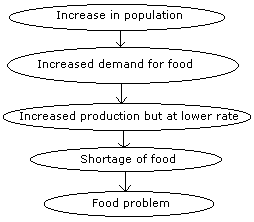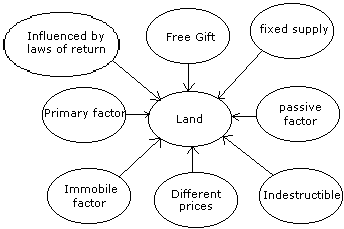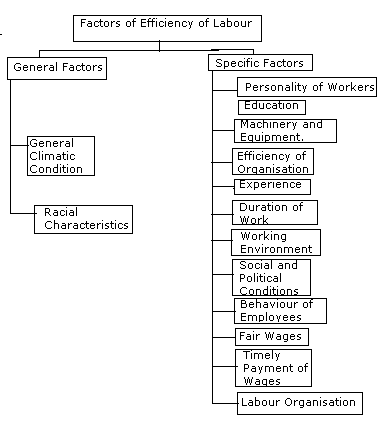ICSE Set Qa1 Year Icse Economic99 Qa1.php Economics Exam Paper for students online
| Q 10 (a)
What is Economic Planning ? Explain the reasons for the three Annual Plans
of 1966-'68, 1968-'69. Ans. 10 (a) The planning is the process by which pre-determined goals are achieved by allocating the available resources within a specific period of time. Therefore in planning the following three points are emphasized .
Definition :- "A scheme of economic organization in which individual and separate units, enterprises and industries are treated as coordinated units of one single system for the purpose of utilizing available resources to achieve the maximum satisfaction of the people's need within a given time." Prof Lewis Reasons for plan holiday:- The three annual plans were implemented after the failure of the 3rd five year plan from 1966-67, 1967-68 and 1968-69. The main reasons of this plan holidays are the following :- 1. Failure of IIIrd Five Year Plan :- The IIIrd five year plan failed badly to achieve its pre-determined targets . 2. Failure of monsoon in the year 1965-66 :- Due to poor monsoon, the production in agriculture sector fell down considerably which resulted in inflation in the economy. 3. Foreign exchange crisis :- The country faced the foreign exchange crisis and due to this , the devaluation of Indian rupee took place in the year 1966. Due to the above mentioned reasons, the govt .could not implement the fourth five year plan in time and instead of that it introduced three annual plans. Q 10 (b) Discuss any
four functions of the Government in economic development. I Reduction in the Inequalities of Income and Wealth :- In most of the economies the distribution of income and wealth is unequal. It is not a desired goals from the point of view of the economies of welfare. It is true that the perfect equality of income and wealth is not possible . The welfare govt. in the modern economies always try to achieve the goal of equal distribution of income and wealth through the various measures like taxation on higher income, public distribution in favour of poors. etc. 2. Full employment :- The full employment is that situation in the economy when the involuntary unemployment is reduced to zero or to a minimum possible level. The govt. tries to provide employment to all the working population in the economy. For the achievement of this goal the govt. tries to increase the rate of capital formation which always results in production oriented employment in the economy. 3. Improvement in the standard of living :- The main objective of the economic development is welfare of the society. One of the criteria for measurement of the welfare and economic growth is the improvement in the standard of living of the people for this the real per capital income should go up in the society. 4. Social security :- People in developing countries have low income and feel insecure due to this reason. In case of unemployment ,sickness or accident, they feel much insecure. In case of the death of the earning hand in the family, family members feel more insecure. The reasons given above forced the govt to come forward . The govt should follow the method of social insurance schemes to improve social security in the country specially for lower income people.
|
| Q 11 (a)
Discuss any four reasons to show that rapid industrialisation of our
country is essential. Ans.11(a) Predominantly Indian economy is an agricultural economy therefore the rapid industrialization is must for the economy due to the following reasons:- 1. To Increase the National Income :- The industrialization can provide a continuous and secure basis for the rapid growth of income. Man by putting in more efforts can increase production and hence income. 2. To Increase the Employment Opportunity :- In India too much population depends on agriculture . The agriculture sector is marked by the seasonal and disguised unemployment . The rapid industrialization can provide the employment to the surplus labour from agriculture sector. 3. Increase the Capital Formation :- Due to increase in the industrialization, the employment will increase , which resulted in the increase in the income and saving . Increased saving will lead to increase in capital formation which will further lead to faster economic growth. 4. Balanced Economy :- The increased industrialization will reduce the dependence on agriculture. As a result there will be balanced growth of all the sectors in the economy. Q 11 (b) What is
fiscal policy ? How can fiscal policy be used for economic development . The fiscal policy can help economic development in the following way :- 1. It increases the aggregate savings in the economy by applying the cuts in the private and public consumption. Increase in saving increases capital formation. 2. It helps in directing the resources from less productive use to more productive uses and from socially less desirable uses to more desirable uses. 3. The fiscal policy helps the economies by safe-guarding it against inflation. 4. The fiscal policy eliminates the sectoral imbalances arising in the economy from time to time. 5. It helps in reducing the glaring economic inequalities by bringing about an equitable distribution of income and wealth. |




